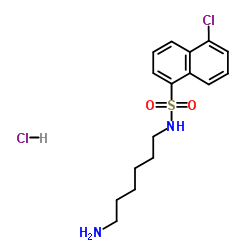W-7 hydrochloride

W-7 hydrochloride structure
|
Common Name | W-7 hydrochloride | ||
|---|---|---|---|---|
| CAS Number | 61714-27-0 | Molecular Weight | 377.329 | |
| Density | N/A | Boiling Point | 518.8ºC at 760 mmHg | |
| Molecular Formula | C16H22Cl2N2O2S | Melting Point | 220-222 °C | |
| MSDS | Chinese USA | Flash Point | 267.6ºC | |
Use of W-7 hydrochlorideW-7 hydrochloride is a selective calmodulin antagonist. W-7 hydrochloride inhibits the Ca2+-calmodulin-dependent phosphodiesterase and myosin light chain kinase with IC50 values of 28 μM and 51 µM, respectively[1][2]. W-7 hydrochloride induces apoptosis and has antitumor activity[3]. |
| Name | N-(6-aminohexyl)-5-chloronaphthalene-1-sulfonamide,hydrochloride |
|---|---|
| Synonym | More Synonyms |
| Description | W-7 hydrochloride is a selective calmodulin antagonist. W-7 hydrochloride inhibits the Ca2+-calmodulin-dependent phosphodiesterase and myosin light chain kinase with IC50 values of 28 μM and 51 µM, respectively[1][2]. W-7 hydrochloride induces apoptosis and has antitumor activity[3]. |
|---|---|
| Related Catalog | |
| Target |
IC50: 28 μM (Phosphodiesterase) and 51 µM (Myosin light chain kinase)[1] |
| In Vitro | W-7 is distributed mainly in the cytoplasm, and inhibits proliferation of Chinese hamster ovary K1 (CHO-K1) cells. W-7 selectively blocks the phase of the cell cycle (G1/S boundary phase) in a manner. 25 μM W-7 arrests the growth of the cells at the G1/S boundary phase of the cell cycle[1]. W-7 (100 μM) exhibits a similar extent of antagonism between the contractile responses to carbachol and KCl. The increase in myosin light chain (P-LC) phosphate content in response to 1-min stimulation with 10 μM carbachol is inhibited by W-7. W-7 antagonizes the smooth muscle contraction through the inhibition of the initial increase in the P-LC phosphorylation[2]. Treatment with W-7 results in the dose-dependent inhibition of cell proliferation in various human multiple myeloma cell lines. W-7 induces G1 phase cell cycle arrest by downregulating cyclins and upregulating p21cip1. W-7 induces apoptosis via caspase activation; this occurred partly through the elevation of intracellular calcium levels and mitochondrial membrane potential depolarization and through inhibition of the STAT3 phosphorylation and subsequent downregulation of Mcl-1 protein[3]. W-7 competitively inhibits Ca2+/calmodulin-dependent phosphodiesterase with a Ki value of 300 μM[4]. |
| In Vivo | W-7 (3 mg/kg; intraperitoneal injection; on 5 consecutive days per week; female BALB/c nu mice) treatment significantly reduces tumor growth in a murine MM model[3]. Animal Model: Female BALB/c nu mice (6-week-old) injected with RPMI 8226 cells[3] Dosage: 3 mg/kg Administration: Intraperitoneal injection; on 5 consecutive days per week Result: Significantly reduced tumor growth in a murine MM model. |
| References |
| Boiling Point | 518.8ºC at 760 mmHg |
|---|---|
| Melting Point | 220-222 °C |
| Molecular Formula | C16H22Cl2N2O2S |
| Molecular Weight | 377.329 |
| Flash Point | 267.6ºC |
| Exact Mass | 376.077911 |
| PSA | 80.57000 |
| LogP | 6.26460 |
| Storage condition | −20°C |
| Water Solubility | methanol: 25 mg/mL, clear, colorless |
| Personal Protective Equipment | Eyeshields;Gloves;type N95 (US);type P1 (EN143) respirator filter |
|---|---|
| Hazard Codes | Xi |
| Safety Phrases | S22-S24/25 |
| RIDADR | NONH for all modes of transport |
| WGK Germany | 3 |
| RTECS | QK0786000 |
|
Genetic mapping of targets mediating differential chemical phenotypes in Plasmodium falciparum.
Nat. Chem. Biol. 5 , 765-71, (2009) Studies of gene function and molecular mechanisms in Plasmodium falciparum are hampered by difficulties in characterizing and measuring phenotypic differences between individual parasites. We screened... |
|
|
Calmodulin antagonists induce cell cycle arrest and apoptosis in vitro and inhibit tumor growth in vivo in human multiple myeloma.
BMC Cancer 14 , 882, (2014) Human multiple myeloma (MM) is an incurable hematological malignancy for which novel therapeutic agents are needed. Calmodulin (CaM) antagonists have been reported to induce apoptosis and inhibit tumo... |
|
|
Calmodulin and PI(3,4,5)P₃ cooperatively bind to the Itk pleckstrin homology domain to promote efficient calcium signaling and IL-17A production.
Sci. Signal. 7(337) , ra74, (2014) Precise regulation of the kinetics and magnitude of Ca(2+) signaling enables this signal to mediate diverse responses, such as cell migration, differentiation, vesicular trafficking, and cell death. W... |
| W-7 |
| n-(6-aminohexyl)-5-chloronaphthalene-1-sulfonamide hydrochloride |
| 1-Naphthalenesulfonamide, N-(6-aminohexyl)-5-chloro-, hydrochloride (1:1) |
| N-(6-Aminohexyl)-5-chloro-1-naphthalenesulfonamide,HCl |
| W-7 HYDROCHLORIDE |
| N-(6-Aminohexyl)-5-chloro-1-naphthalenesulfonamide hydrochloride (1:1) |
| N-(6-Aminohexyl)-5-chloro-1-naphthalenesulfonamide monohydrochloride |
| MFCD00012559 |
| L66J BSWM6Z GG &&HCl |
| N-(6-Aminohexyl)-5-chloro-1-naphthalenesulfonamide hydrochloride |
| N-(6-aminohexyl)-1-naphthalene sulfonamide hydrochloride |
| N-(6-Aminohexyl)-5-chloro-1-naphthalenesulfonamide, hydrochloride (1:1) |
| N-(6-Aminohexyl)-5-chloronaphthalene-1-sulfonamide hydrochloride (1:1) |

